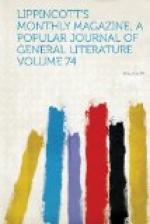A long and rather narrow room in front of the class-rooms was shown us as the refectoire, where the Brontes, with the other boarders, took their meals, presided over by M. and Madame Heger, and where, during the evenings, the lessons for the ensuing days were prepared. Here were held the evening prayers, which Charlotte used to avoid by escaping into the garden. This, too, was the scene of M. Paul’s whilom readings to teachers and pupils, and of some of his spasms of petulance, which readers of “Villette” will remember. From the refectoire we passed again into the corridor, where we made our adieus to our affable conductress. She gave us her card, and explained that, whereas this establishment had formerly been both a pensionnat and an externat, having about seventy day-pupils and twenty boarders when Miss Bronte was here, it is now, since the death of Madame Heger, used as a day-school only,—the pensionnat being at some little distance, in the Avenue Louise, where Mademoiselle is a co-directress.
The genuine local color Miss Bronte gives in “Villette” enabled us to be sure that we had found the sombre old church where Lucy, arrested in passing by the sound of the bells, knelt upon the stone pavement, passing thence into the confessional of Pere Silas. Certain it is that this old church lies upon the route she would naturally take in the walk from the Rue d’Isabelle to the Protestant cemetery, which she had set out to do that dark afternoon, and the narrow streets of picturesque old houses which lie beyond the church correspond to those in which she was lost. Certain, too, it is said to be that this incident is taken directly from Miss Bronte’s own experience. A writer in “Macmillan” says, “During one of the long holidays, when her mind was restless and disturbed, she found sympathy, if not peace, in the counsels of a priest in the confessional, who pitied and soothed her troubled spirit without attempting to enmesh it in the folds of Romanism.”
Our way to the Protestant cemetery, a spot sadly familiar to Miss Bronte, and the usual termination of her walks, lay past the site of the Porte de Louvain and out to the hills a mile or so beyond the old city limits. From our path we saw more than one tree-surrounded farm-house which might have been the place of M. Paul’s breakfast with his school, and at least one old-fashioned manor-house, with green-tufted and terraced lawns, which might have served Miss Bronte as the model for “La Terrasse,” the suburban home of the Brettons, and probably the temporary abode of the Taylor sisters whom she visited here. From the cemetery are beautiful vistas of farther lines of hills, of intervening valleys, of farms and villas, and of the great city lying below. Miss Bronte has well described this place: “Here, on pages of stone, of marble, and of brass, are written names, dates, last tributes of pomp or love, in English, French, German, and Latin.” There are stone crosses all about, and great thickets of roses and yew-trees,—“cypresses that stand straight and mute, and willows that hang low and still;” and there are “dim garlands of everlasting flowers.”




